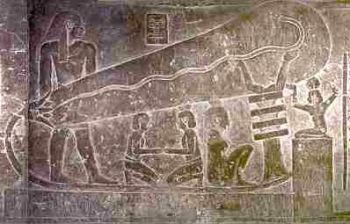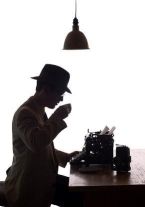
Publisher:
Bonnie King
CONTACT:
Newsroom@Salem-news.com
Advertising:
Adsales@Salem-news.com

~Truth~
~Justice~
~Peace~
TJP
Aug-20-2010 17:51

 TweetFollow @OregonNews
TweetFollow @OregonNews
Did Ancient Egyptians Possess the Electric Light?
Terrence Aym Salem-News.comSeveral years ago this exact experiment was conducted by the Discovery Channel.
 Relief on the temple crypt wall at Hathor. Courtesy: Relief on the temple crypt wall at Hathor |
(CHICAGO) - Who discovered electricity and then harnessed it to create an artificial light source? Benjamin Franklin and Thomas Edison are the respective gentlemen--at least that's the answer which has been accepted as fact.
A Stunning Hypothesis
There's a growing contingent of researchers, however, claiming that we should no longer accept that popular version. They contend that electricity was originally discovered in the ancient world and the Egyptian priesthood was the first to harness the power to illuminate their underground tombs.
A series of reliefs cover the walls in an obscure corner of a crypt in the Hathor Temple in Dendera. One in particular caught the eye of a visiting Norwegian electrical engineer. He stared at it not sure he believed his own eyes. What he was certain he'd found was an Egyptian depiction of an electric light bulb.
Crookes tubes
His revelation was called to the attention of other electrical engineers. After studying the relief they agreed that it certainly seemed to depict an electric light. Comparing the design to types of bulbs they reached a consensus: ancient Egyptians had working bulbs called "Crookes tubes."
"When the [Crookes] tube is in operation, the ray originates where the cathode electrical wire enters the tube to the opposite end. In the temple picture, the electron beam is represented as an outstretched serpent. The tail of the serpent begins where a cable from the energy box enters the tube, and the serpent's head touches the opposite end. In Egyptian art, the serpent was the symbol of divine energy . . ." - Chris Dunn, "The Giza Power Plant."
To fully understand why the electrical engineers were excited by the discovery, and why they believe the ancient Egyptians had Crookes tubes, please study the two photos that are hyperlinked below:
Relief on the temple crypt wall at Hathor: click here world-mysteries.com/fd_lamp.jpg
Two Crookes tubes in operation: click here upload.wikimedia.org/wikipedia/commons/b/bf/Crookes_tube_two_views.jpg
The similarity is undeniable, and it certainly seems like it could be true, yet could ancient Egypt really have possessed such advanced technology? Yes, say some electrical engineers.
No soot
The proponents of the hypothesis argue that throughout ancient Egypt temples and crypts with intricate carvings, reliefs and wall paintings exist where no light was available. Torches or lamps may have been used, but no trace of soot can be found. Some tombs are deep underground and have a maze of tunnels and rooms that had to have been lit. There are no places to hold torches, however, and no traces of soot marks on the walls or ceiling.
Some who oppose the electric light hypothesis argue that the Egyptians may have used a series of polished mirrors to direct sunlight around corners and into the deepest areas of crypts. Yet the Egyptian mirrors were made of polished copper and would have been unable to reflect light with enough intensity to bounce off seven or eight or more mirrors and get sufficient light into the bowels of the underground chambers.
Several years ago this exact experiment was conducted by the Discovery Channel. Not only was the strength of the light reaching into the crypt insufficient to illuminate the interior walls, the sun continually moved across the sky necessitating the constant re-adjustment of the main mirror.
Working replica of the 'Egyptian light bulb'Another researcher decided to build a Crookes tube copying the exact design found on the wall at Hathor. The bulb worked. A photo of it can be found here. theforbiddenknowledge.com/jeffrense/egyptlight02.jpg
If you study the relief, you can see that the center of the "bulb" has a snake shape. The bulb itself is fixed to a base from which something like a cord is attached. Near the large end of the bulb is a support pillar that has two electrodes embedded into the interior of the bulb near the "snake." This has been identified by electrical engineers as opposing filaments.
Complete article here: helium.com/items/1660034-did-the-ancient-egyptians-invent-the-electric-light
 Terrence Aym is a Salem-News.com Contributor based in Chicago, who is well known nationally for his stirring reports on the top ranked site, helium.com. Born in Minnesota, Terrence Aym grew up in the Chicagoland suburbs. Having traveled to 40 of the 50 states and lived in 7 of them, Aym is no stranger to travel. He's also spent time in Canada, Mexico, the Caribbean, Europe, Asia and Western Africa. An executive for many years with Wall Street broker-dealer firms, Aym has also had a life-long interest in science, technology, the arts, philosophy and history. If it's still possible to be a 'Renaissance man' in the 21st Century, Aym is working hard to be one.
Terrence Aym is a Salem-News.com Contributor based in Chicago, who is well known nationally for his stirring reports on the top ranked site, helium.com. Born in Minnesota, Terrence Aym grew up in the Chicagoland suburbs. Having traveled to 40 of the 50 states and lived in 7 of them, Aym is no stranger to travel. He's also spent time in Canada, Mexico, the Caribbean, Europe, Asia and Western Africa. An executive for many years with Wall Street broker-dealer firms, Aym has also had a life-long interest in science, technology, the arts, philosophy and history. If it's still possible to be a 'Renaissance man' in the 21st Century, Aym is working hard to be one.
Aym has several book projects in the works. Media sites that have recently featured Aym, and/or discussed his articles, include ABC News, TIME Magazine, Business Insider, Crunchgear.com, Discover, Dvice, Benzinga and more recently, his work has been showing up in South Africa and Russia.
Articles for August 19, 2010 | Articles for August 20, 2010 | Articles for August 21, 2010

Quick Links
DINING
Willamette UniversityGoudy Commons Cafe
Dine on the Queen
Willamette Queen Sternwheeler
MUST SEE SALEM
Oregon Capitol ToursCapitol History Gateway
Willamette River Ride
Willamette Queen Sternwheeler
Historic Home Tours:
Deepwood Museum
The Bush House
Gaiety Hollow Garden
AUCTIONS - APPRAISALS
Auction Masters & AppraisalsCONSTRUCTION SERVICES
Roofing and ContractingSheridan, Ore.
ONLINE SHOPPING
Special Occasion DressesAdvertise with Salem-News
Contact:AdSales@Salem-News.com

Salem-News.com:
googlec507860f6901db00.html

Terms of Service | Privacy Policy
All comments and messages are approved by people and self promotional links or unacceptable comments are denied.
[Return to Top]
©2025 Salem-News.com. All opinions expressed in this article are those of the author and do not necessarily reflect those of Salem-News.com.